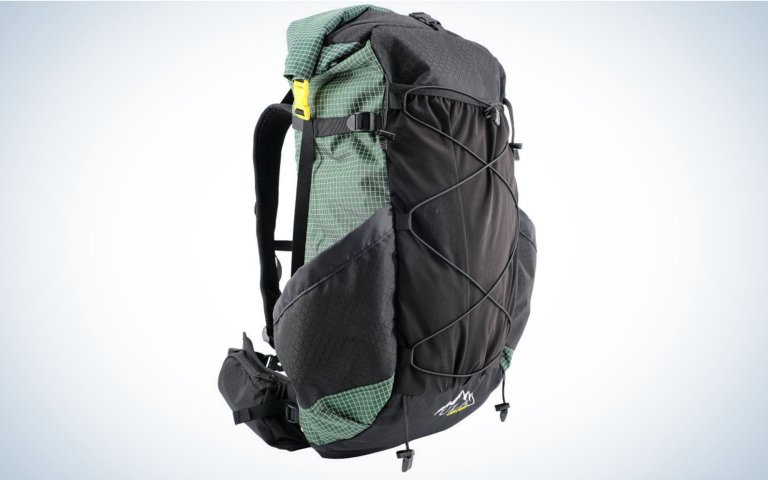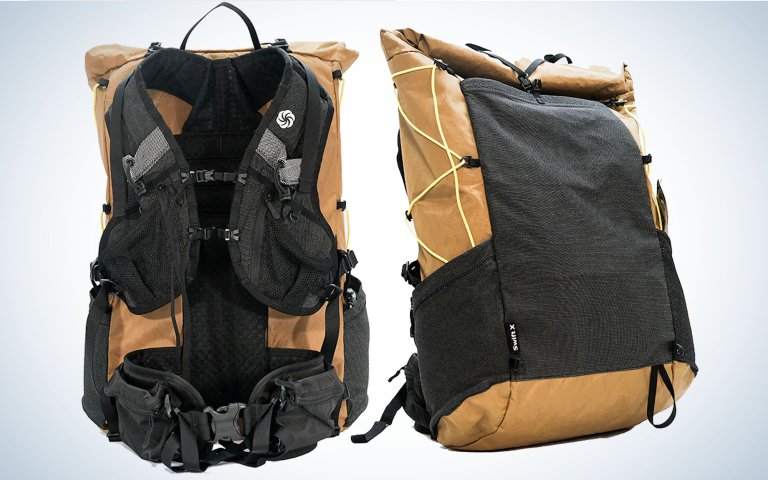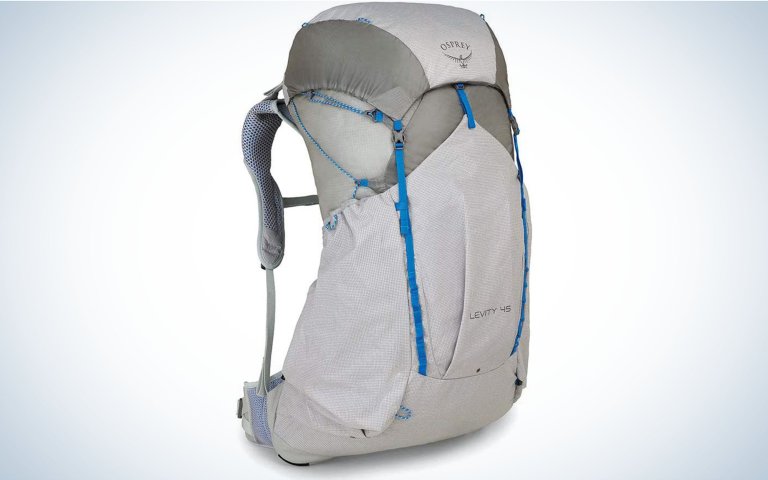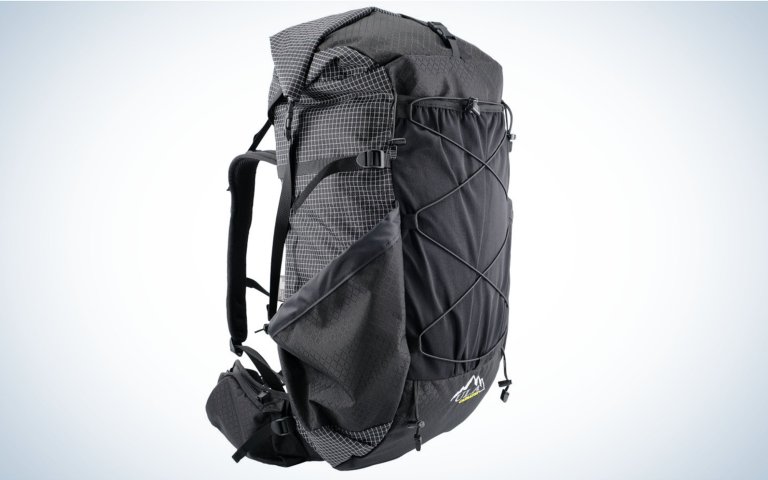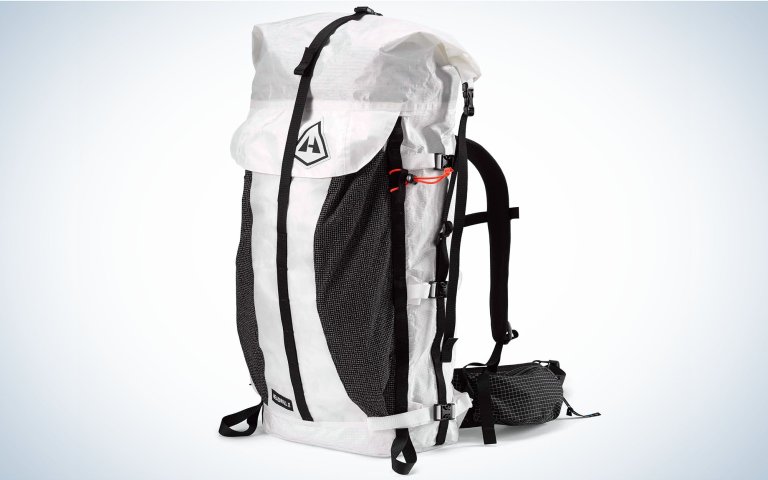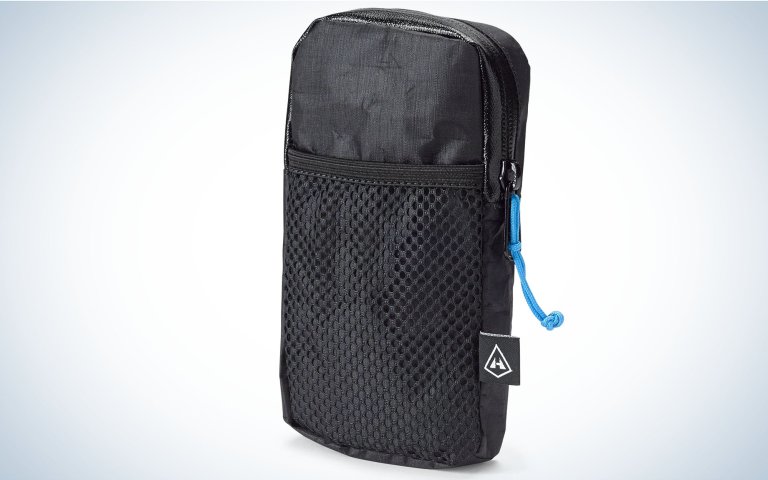We may earn revenue from the products available on this page and participate in affiliate programs. Learn More ›
If you’ve gone backpacking anytime in the last decade you’ve probably noticed that thru hiking backpacks are starting to get small—really small. The 70-liter external-frame packs of yore are quickly going by the wayside in favor of svelte 35-liter frameless (sometimes even hipbelt-less) designs. These packs are allowing backpackers to go farther and faster than even before, but with so many options to choose from, from cottage companies to the likes of Osprey and Hyperlite, it’s hard to know which to pick. To help you select the right pack, we chatted with four thru-hikers that have kicked out a number of major long trails to find out what they started with, and what they are using now. Here are their picks for the best thru hiking backpacks.
- Most Durable: ULA Circuit
- Most Versatile: Six Moons Swift X with Flight Vest Harness
- Best for Sweaty Hikers: Osprey Levity 45
- Best Large Capacity: ULA Catalyst
- Best for Winter: Hyperlite Mountain Gear Headwall
- Best Add-On: Hyperlite Mountain Gear Phone Pouch
How We Selected the Best Thru Hiking Backpacks
For this story, I spoke with four different ultralight backpackers that had hiked over 10,000 miles each. Three of them were triple crowners, having hiked the Appalachian Trail, Pacific Crest Trail, and Continental Divide Trail. Like with any piece of gear, their selections represent their depth and breadth of experience, but also their own personal preferences and what worked for their body type. Whenever possible, it’s best to try out as many ultralight backpacks as possible before making a final selection (as several individuals I spoke with suggested). Many ultralight backpack manufacturers can be found at long-distance trail events, such as PCT Days and Trail Days.
Best Thru Hiking Backpacks: Reviews & Recommendations
Most Durable: ULA Circuit
Most Durable
ULA Circuit
See ItPros
- Durable enough for 10,000+ miles
- Great customer service
Cons
- Somewhat heavier than other UL models out there
Key Features
- Weight: 37.3 ounces
- Max Load: 35 pounds (ULA recommendation); 50 pounds (Outro assessment)
- Total Volume: 68 liters
- <a href="https: //www.outdoorlife.com/gear/bear-can-testing/” rel=”noreferrer noopener”>Bear Can Compatible: Yes, vertical only
- Also available in Ultra
Lindsay “Outro” Brisko started out with a ULA Circuit on her thru-hike of the Appalachian Trail in 2015, and she was still using it when she wrapped up her hike of the Continental Divide Trail two years later, having hiked the Pacific Crest Trail in between. Then she hiked the 750-mile Oregon Coast Trail and the 170-mile Cohos in New Hampshire, still with the same pack. She uses that same ULA Circuit today.

There are a few reasons why this pack worked so well for Outro across the span of her thru-hiking career. First off, at 68 liters, the Circuit is a pretty spacious pack, capable of holding the too-much gear that first-time thru-hikers inevitably bring as well as the long water hauls along the Pacific Crest and Continental Divide Trails. It has a minimal frame, just a suspension hoop and a metal frame stay, which Outro found comfortable up to 50 pounds, even though ULA only rates it for a maximum load of 35.
Outro’s favorite part of the ULA Circuit was how well made it was. Part of this is the construction of the pack, which is designed to minimize fail points (the only zippers are found at the hip belts). But what really stood out to her was ULA’s customer service. When, after thousands of miles, she sent it in to have the water-resistant membrane repaired, they offered to replace the whole pack for her for free. (She declined, as she has made a number of her own customizations over the years). In fact, she ended up going so deep into customization that Outro started making her own outdoor gear for sale.
Most Versatile: Six Moons Swift X with Flight Vest Harness
Most Versatile
Six Moons Swift X with Flight Vest Harness
See ItPros
- Removable frame
- Generous size
- Plenty of pockets
Cons
- Takes some time to adjust to
Key Features
- Weight: 40.2 ounces
- Max Load: 35 pounds
- Total Volume: 49 liters
- Bear Can Compatible: Yes
- Also available in Ultra
When Jac “Top Shelf” Mitchell first tried the running vest shoulder-strap variation of the Six Moons Swift X, she wasn’t sure if it was for her. “I had to get used to how to adjust it for my body and then my body had to get used to carrying weight differently,” she said. “It’s a completely different shoulder strap setup.” These straps are thinner, wider, and unpadded, covering more of your chest than a typical shoulder strap. But that shape also means that they can support larger pockets.

At 49 liters, the Six Moons Swift X has a larger capacity than most other thru hiking backpacks. To give backpackers the option to give further support to the extra weight, it has a removable frame inside, which helps to channel weight down to the hip belt (although this also changes how the backpack carries on her back).
Best for Sweaty Hikers: Osprey Levity 45
Best for Sweaty Hikers
Osprey Levity 45
See ItPros
- Great warranty
- Low weight
- Great ventilation
Cons
- Fragile
Key Features
- Weight: 29.6 ounces
- Max Load: 20 pounds (Osprey); 30-35 pounds (Lunar assessment)
- Total Volume: 45 liters
- Bear Can Compatible: Yes, vertical only
Reuben “Lunar” Stugart started his southbound Appalachian Trail hike in 2007 with the 80-liter Gregory Whitney, a seven-and-a-half-pound backpack. That’s not the backpack he’s using today—it’s not even the backpack he finished the AT with.
The next backpack he tried out was the 65-liter Osprey Atmos. “That one was great. I actually used that one all the way through the AT,” he said. Lunar used that same pack for the next 12 years, but when he finally replaced his Atmos, through Osprey’s warranty program, the pack had been redesigned and was almost double the weight it had been before. So he switched again, to the Osprey Levity.

For Lunar, the appeal of the Osprey packs is their back panel ventilation. “I don’t like being hot,” he said. “I get a lot of skin issues when I am too hot for extended periods, which is what you are doing when you’re backpacking.”

Not that he thinks the Levity is a perfect pack. “If you’re not careful with it, it tears pretty easily,” he said. “The materials that they use just do not stand up well to abrasion, and being dropped. But that’s how they got it so light.”
Best Large Capacity: ULA Catalyst
Best Large Capacity
ULA Catalyst
See ItPros
- Can fit a bear can horizontal
- Spacious enough for extended seasons and even winter kits
Cons
- Heavier than other UL options available
Key Features
- Weight: 44.4 ounces
- Max Load: 40 pounds (ULA recommendation)
- Total Volume: 75 liters
- Bear Can Compatible: Yes
- Also available in Ultra
Nicholas “Wandering Kiltsman” Cornett didn’t pause much in between his triple crown hikes (2019-2021). “I would just take a month off and just sit and eat ice cream and gain back the weight, because you lose a ton,” he told me. “Then I’d hike a short trail, like the Florida Trail (1,500 miles) and the Pinhoti Trail (335 miles). I’d take a month off a year, and I think that’s enough.”
While the Wandering Kiltsman started on the Appalachian Trail with the ULA Catalyst, he admits that that pack was probably more than he needed. “I was carrying way too much weight,” he said. “As we all do. I was carrying maybe 42 pounds in it.” He then switched to the ULA Ohm, a somewhat smaller, less supportive version of the Circuit, for the rest of that hike.
The Wandering Kiltsman ended up keeping the Catalyst in his arsenal for certain sections of the Continental Divide and Pacific Crest Trails. “If I was in a heavy snow section or a section where I needed to use a bear can I used the Catalyst,” he said.
Best for Winter: Hyperlite Mountain Gear Headwall
Best for Winter
Hyperlite Mountain Gear Headwall
See ItPros
- Designed to hold typical winter backcountry gear
- Light enough for single-day trips
Cons
- Not a great pack for year-round use
Key Features
- Weight: 41.6 ounces
- Max Load: 40 pounds (Hyperlite recommendation)
- Total Volume: 55 liters
- Bear Can Compatible: Yes
Lunar uses Hyperlite Mountain Gear packs for his winter trips, as well as any trip that’s more gear intensive. “It’s designed as a mountaineering pack, so it handles that kind of stuff,” he said. While he doesn’t use HMG for his summertime thru-hiking (due to the lack of back panel ventilation and exterior storage pockets), it’s his go-to for treks in Alaska and other, more rugged locales. He does add some storage to the interior of the pack to compensate for its lack of pockets. So if you need the best thru hiking backpack for winter, check this one out.
Best Add-On: Hyperlite Mountain Gear Phone Pouch
Best Add-On
Hyperlite Mountain Gear Phone Pouch
See ItPros
- Can be used on different backpacks (not just HMG)
- Easy to grab your phone and other small essentials on the go
Cons
- Somewhat expensive
Key Features
- Weight: 1.4 ounces
- Dimensions: 7 inches x 3.5 inches x 1.25 inches
- Water resistant
Several of the long-distance hikers I spoke to had altered their pack in some way to better fit their needs. While some of these customizations were handmade, Lunar added the HMG phone pouch onto the shoulder strap of his Osprey Levity pack to more easily access it on the go. Given the number of roles that a smartphone plays in a typical ultralight backpackers kit — phone, maps, photos, music, satellite messenger texting — consider adding this pouch to your bag if it doesn’t already come with a dedicated spot for your phone on the front shoulder straps.
Things to Consider Before Buying One of the Best Thru Hiking Backpacks
The Rest of the Big 3
Your backpack, tent, and sleep system are considered the big three items for backpacking as they account for the most pounds in your base weight. It’s important to spend as much care on choosing one of the best backpacking tents and a top-notch sleep system, including one of the best backpacking sleeping pads and one of the best backpacking quilts, before heading out on your big trek.
Capacity
While small 35-liters packs are increasingly common, all the triple crowners I spoke to were using 40- to 45-liter packs, and sometimes models that were even larger. Of course, they noted that the size pack you need depends on the size of the rest of your gear. “The sleeping bag is what makes you need more volume inside the pack than anything,” Lunar said.
Customization
Outro remembers walking into the Saufley’s trail angel compound along the Pacific Crest Trail and having a lightning bolt moment. There were sewing machines there for hikers to fix their gear and she realized that she could alter her pack any which way she wanted to suit her. Her current modifications include a quiver for her hiking poles along the back, so that she can easily grab them without stopping. Multiple hikers also used trash compactor bags inside of their bag for additional water protection.
Ease of Access
For Lunar, being able to reach your gear when you need it is one of the most important features of an ultralight backpack. “I want my water to be not only accessible, but easily refillable,” he said. “I want to be able to get to my phone so I can bring it out quickly if I see a critter I want to capture.” He also likes a large outside pouch so that his gear is easily accessible, as well as pockets so that he can grab snacks on the go.
Hip Belts
While it’s becoming increasingly common for ultralight hikers to forgo hip belts entirely, Outro thinks that they are worth it for the longer, heavier carries that are inevitable on more remote long trails, as they help to transfer weight from your shoulders to your hips.
Be Willing to Experiment
One of the most striking things about talking to accomplished long-distance hikers is how varied their strategies are. “It’s figuring out what works for you,” said Lunar. “It’s your opinion. There are certain things that are true for a lot of people, but it’s not the same for everyone.”
“You fall in love with your first backpack,” said the Wandering Kiltsman. “But my first backpack was a Mountainsmith.” He went on to note that even though the cost of a single backpack might not seem exorbitant when you first start out, by the end of a hike like the Continental Divide Trail, the centrality of a quality backpack to the trail experience made those costs seem less significant once you’ve got thousands of miles under your belt.
Find Your Head Space
While the Triple Crowners I talked to could have gone on for hours about their gear, they were also adamant that there are virtually no wrong gear choices. “It’s all mentality,” said the Wandering Kiltsman, “So if you say ‘I’m going to finish,’ then you’re going to finish with a water bottle and your pocket stuffed with food.”
Read Next: What Is Thru-Hiking?
FAQs
The Nashville Cutaway Pack is one of the lightest backpacks on the market, but resist the urge to choose an ultralight backpack on weight alone. It must also be a comfortable carry for your intended load and frame.
The benefits of ultralight backpacking depend on your average mileage. If your backpacking trips typically involve hiking five to ten miles to a mountain lake, then lounging in a hammock with a beer, you will likely be happier with a traditional backpacking backpack, which are designed to carry heavier loads comfortably for short distances. If you’re hoping to knock successive twenty- or thirty-mile days deep into the backcountry, then an ultralight backpack can help reduce the overall load on your legs and feet.
Typically more than 25 pounds for all your gear (minus food and water) is too heavy for a backpacking backpack, but this varies significantly from person to person. If you’re headed out for your first backpacking trip, avoid the temptation to overpack, as excess weight will quickly become uncomfortable.
Forty-five liters is a very comfortable size for most backpacking trips, capable of carrying enough food and water for up to five days at a time. Larger 60- or 75-liter packs are a great choice if you plan to head out for more than a week at a time or if you’ll be carrying gear for more than just yourself. Smaller 30-liter packs are typically used by fastpackers to cover very large daily distances (35+ miles), cutting down on the amount of excess food and water they need to carry a time.
While ultralight backpacking can sometimes feel like a race to the bottom—cutting it down to 15 pounds, then 10, then five—most experienced ultralight backpackers aren’t overly focused on base weight. Different treks will call for different gear sets, have different water carries, longer or further resupply distances. If you’re new to ultralight backpacking, first check the recommended weight limit for your backpack and compare that to the kit you are planning to carry into the backcountry.
There are some similarities between packing a traditional backpacking backpack and packing an ultralight backpack. With both, centering the heaviest items in your pack at the middle of your back will help to balance the weight and reduce unnecessary drag. You’ll also want to ensure that items you use the most often—base layers, water filters, snacks—are packed in an easily accessible spot. But whereas traditional backpacks typically have many pockets, with multiple access points to the main compartments, most of the best thru hiking backpacks have only a fraction of these, and top-entry only.
This helps to keep the weight down, but it can also cause issues if an important piece of gear gets packed at the bottom of the main compartment. Experienced ultralight backpackers typically pack their sleep system at the bottom of their backpack, and then layer up with their tent, extra food and cookware, stashing their extra layers for the day at the top of their pack. While there are typically fewer pockets on an ultralight backpack than a traditional backpack, they are often significantly larger, especially the front mesh, or stuff-it, pocket.
Ultralight backpackers are also notorious for having no internal organization compartments. Outro told me that when she was starting out, she had different stuff sacks for her gear. “Someone asked why do you have a stuff sack? Your bag is a stuff sack,” she told me. Now she treats the whole thing like it’s a giant duffle.
Read Next: Hyperlite Southwest 40 Ultralight Backpack Review
Final Thoughts on the Best Thru Hiking Backpacks
We’re living in a golden age of ultralight gear—there is nearly endless innovation going on in the structure and materials out there, from the one-man cottage companies to REI mainstays. The challenge for backpackers is finding that just-right fit that can last for years. The best thru hiking backpack recommendations provided by the Triple Crowners and other elite backpackers provided here are a great place to start:
- Most Durable: ULA Circuit
- Most Versatile: Six Moons Swift X with Flight Vest Harness
- Best for Sweaty Hikers: Osprey Levity 45
- Best Large Capacity: ULA Catalyst
- Best for Winter: Hyperlite Mountain Gear Headwall
- Best Add-On: Hyperlite Mountain Gear Phone Pouch

